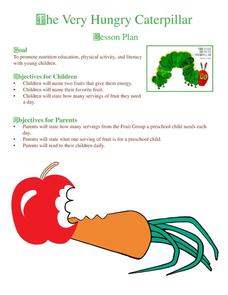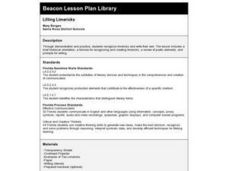Curated OER
Segmenting Syllables Name Game
Clapping out syllables gets more engaging when you're using learners' names. Model some names first, then have the class join you in chanting names with each syllable clapped out. Bring up the difference between multiple-syllable and...
Curated OER
Responding Syllables: Reading and Music
Shell Silverstein’s “Sick” provides an opportunity for kids to demonstrate their understanding of syllables and phonemes. The class creates a list of descriptive words used in the poem that have more than one syllable, and brainstorm how...
Curated OER
Phonemic Awareness: Syllables
Count the syllables in your name, now count the syllables in your friend's name. Kids count syllables as they clap out and segment words. This activity is done as a whole class and has the potential of being highly engaging. The engaging...
Curated OER
Clap Syllable
Students identify the number of syllables in a word. They count the beats in a word and realize that one beat -words are shorter than three beat words.
Curated OER
Sound Blending Lesson Plan
Mr. Snowman wants to help emerging readers understand compound words, so he segments some familiar words to help them see that they are made of two distinct words. Learners repeat the words, both segmented and blended, and observe them...
Curated OER
Clapping Syllables
Students explain that words are made up of parts called syllables. They associate spoken language with written words
Curated OER
Beginning and Ending Sounds - Lesson 1 of 2
Stamp, slap, and clap! Emergent readers demonstrate their awareness of the initial, medial vowel, and final sounds in spoken, short vowel, single-syllable words with a stamp/slap/clap activity. After identifying the letters and sounds of...
Curated OER
Can You Compose?
Fourth graders investigate musical notes. In this music lesson plan, 4th graders compose a short song while clapping the rhythm and singing the syllables using the appropriate notes or rests.
Curated OER
Identifying Syllables Within Spoken Words
First graders participate in a conversation about what they want to become when they grow up, and identify syllables within the spoken words.
Meadows Center for Preventing Educational Risk, University of Texas at Austin
Lesson 13 - Multisyllabic Word Reading
One- and two-syllable words may flow from the tongue with ease, but longer words, such as department and volcano, feel like tongue twisters. Scaffolded instruction explains how to break words into their individual syllables, and then...
Curated OER
Divide and Conquer: Breaking Down Skills For Slowlearners
Students are introduced to skills to help them become better readers. With a partner, they use magazines to identify consonant pairs and participate in a game naming words that ends with consonants. As a class, they practice clapping...
Curated OER
The Very Hungry Caterpillar
Second graders complete the first column of a KWL chart with information that they know about caterpillars. They listen to a read aloud of Eric Carle's, The Very Hungry Caterpillar, while focusing on what caterpillars eat. They clap out...
Curated OER
Billy Brown and the Belly Button Beastie
Students explore the book Billy Brown and the Belly Button Beastie. In this verb, onomatopoeia, and syllable instructional activity, students pantomime verbs, read onomatopoeia from the story and clap out syllables. Students unscramble...
Curated OER
"I am a pirate with a wooden leg": Stomping Iambic Pentameter
What is blank verse? Iambic pentameter? Meter? Use the attached document to review these ideas with your middle schoolers. This plan has learners get up and stomp to iambic pentameter, which is a fun change from just clapping the meter!
Curated OER
Transferring Rhythmic Patterns From Music to Movement
Students identify and demonstrate movement elements in relation to musical notation. They clap to rhythms, beat on drums, match musical notes to speech patterns and use the rhythms of the their names to create a dance.
Curated OER
Pies and Rhythms
Second graders, using popsicle sticks. illustrate rhythms clapped by someone else. They use different types of pies to recognize and notate rhythms in standard notation.
Curated OER
Play with Words: Rhymes & Verse
Students listen to poems and rhymes, clap out syllables, and sing along with familiar tunes. They use puppets and crafts to help recall and retell favorite poems, and craft their own poems.
Curated OER
Edward Lear, Limericks, and Nonsense: There Once Was?
Students explore limericks. In this poetry writing lesson, students listen to and read a variety of poems written by Edward Lear. Students count syllables and identify meter by clapping as they read aloud. Students complete a limerick...
Curated OER
Word Identification Lesson
Third graders listen to a list of Fall words and then repeat them aloud as a class. They discover how to count syllables either by holding their hand under their chin or clapping and practice together as a class and then split into small...
Curated OER
How Do I Measure Up? (Intermediate)
Fifth graders compare the relationship between meter in music and measurement in math. They practice sightreading music by determining the number of beats per measure, clapping and counting the rhythm.
Curated OER
"All About Me"
Students perform creative movement to music, sing and improvise using the Solfege syllables do, me, so, and la, and recognize beat vs. no beat in this lesson for the Kindergarten General Music class. Emphasis is on a song called "All...
Meadows Center for Preventing Educational Risk, University of Texas at Austin
Lesson 15 - Soft G and Soft C
The names Cindy and Carrie start with the same letter, but have very different sounds. The 15th of 17 word recognition lessons focuses on the soft C sound found in Cindy and the soft G sound found in Gene. Direct instruction starts with...
Curated OER
Lilting Limericks
Young scholars discover the formula for writing limericks and use it to write their own poems.
Curated OER
Learning to Interview
An authentic and engaging way to practice literacy skills, this lesson calls for young language arts pupils to conduct interviews with classmates and family members. First, pupils watch as the teacher models the interview process with a...

























